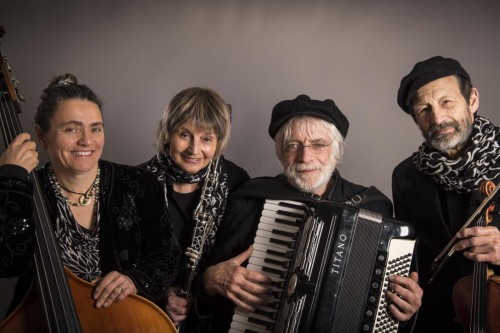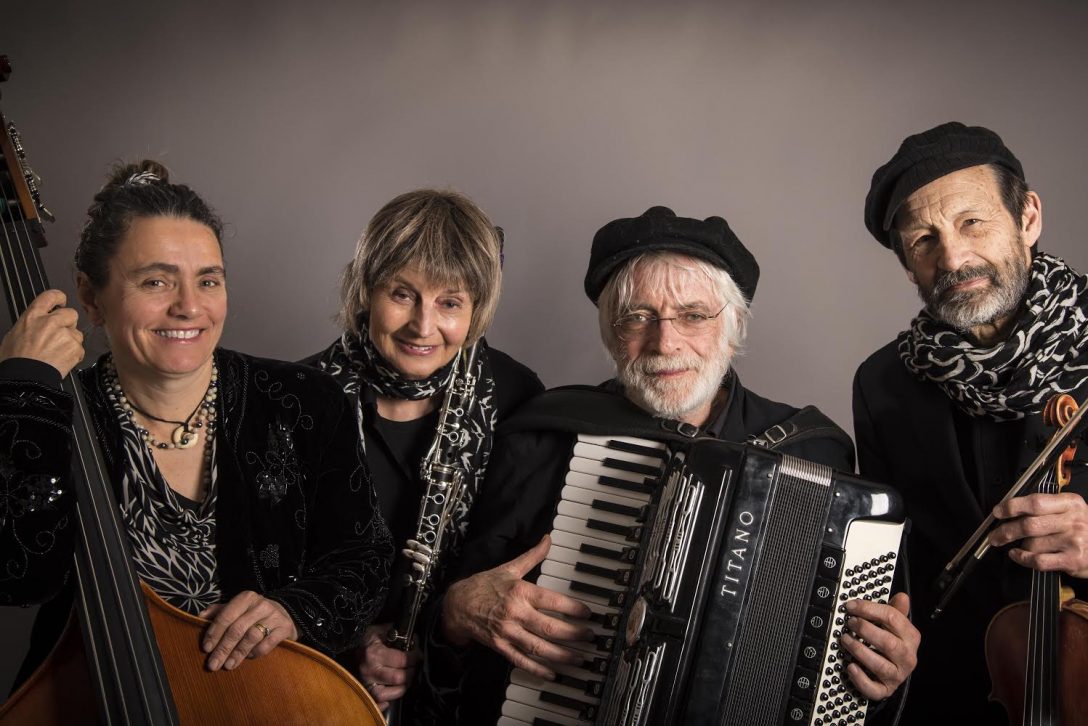 New Zealand Various composers, The Kugels: (Deborah Rawson [clarinet, soprano saxophone, xaphoon] Robin Perks [violin] Ross Harris [accordion] Jacqueline Nordon [double-bass]), The Old Library Music Centre, Whangarei, New Zealand. 9.9.2018. (PSe)
New Zealand Various composers, The Kugels: (Deborah Rawson [clarinet, soprano saxophone, xaphoon] Robin Perks [violin] Ross Harris [accordion] Jacqueline Nordon [double-bass]), The Old Library Music Centre, Whangarei, New Zealand. 9.9.2018. (PSe)

Before I start on this review, there’s something I have to get off my chest. You see, I just knew that, sooner or later, a recital like this one would turn up, by which I mean one that seems not to fit the accepted idea of a ‘chamber recital’. After all, aren’t they supposed to be recitals of classical music? Well, yes, they are – but, hold on a bit and ask yourself, ‘What do we generally mean by ‘classical’ music?’ The most likely reply that comes flying, like a sliding beer-glass, the length of your average saloon bar, is, ‘Well, it’s stuff like Mozart and Beethoven, innit?’ That might be neat, but it’s not the answer. Sure, Beethoven and Mozart did write classical music, but that no more defines it than saying, ‘Well, it’s stuff like Corollas and BMWs, innit?’ defines means of transport. When Mozart was writing his stuff, or Beethoven his, was it considered classical at that time? What about all those fabulous Gershwin songs – are they classical? More recently, Lennon and McCartney also wrote lots of songs – are those classical music? On the other hand, even as I write this, loads of folk are busy writing stacks of brand-new music which most people would immediately call ‘classical’.
Down through the years, many have tried to define ‘classical music’, and come up with alternative names like ‘serious music, ‘art music’ or ‘abstract music’. Hum. ‘Serious music’ is a laugh – since there’s a fair bit that is absolutely hilarious, and unfortunately not always intentionally so. ‘Art music’ is less obviously laughable, but still on the damp side of ridiculous: should I take it that the likes of Lennon and McCartney produced songs which were not art? If so, we would have to exclude all the music which was ‘popular’ at the time it was created, and that would exclude quite a lot of what we now think of as classical, including great swages of music by Haydn and his ilk. ‘Abstract music’ might have filled the bill, except a lot of it isn’t, including every opera, oratorio, cantata and song ever written.
Some people dodge the issue by saying that you should not pigeonhole music. Well, that may indeed be true, but unfortunately most of us insist on discerning boundaries between different sorts of music, no matter how grey and woolly these divisions might be. So, methinks to me-self, what do you reckon about this for a definition: ‘Classical music is music which is independent of, or has outlived its dependence on, particular performers’? Well, it’s not perfect, not by a long chalk, but, in spite of perhaps casting the net too wide, it does seem to avoid most of the pitfalls. Firstly, it covers everything we usually think of as classical. Not only are these independent of particular performances, there’s also an entire industry devoted to selling us competing interpretations. Secondly, the Gershwin songs also fit: nobody these days refuses to listen to I Got Rhythm unless Ethel Merman is singing it. Even the songs of Lennon and McCartney and others are quietly leaking across into the ranks of the ‘classical’.
Sliding smoothly back onto the rails, by that definition I can see no problem at all in having a chamber music recital ‘like this one’, which consists entirely of Klezmer, a significant Jewish folk music form – and that is exactly what we got, courtesy of Chamber Music NZ, in Whangarei Music Society’s third 2018 recital. The Kugels have named themselves (quite appositely) after the Jewish pudding, which – like pancakes – can be sweet or savoury, but always very, very tasty. They are a quartet of musicians apparently on a mission – and to my mind an eminently worthy one – to bring Klezmer to the widest possible audience.
However, none of the four performers is a ‘born and bred’ Klezmer player. As it happens, they are all died-in-the-wool classical – perhaps I should now say ‘core classical’ – musicians. Clarinettist Deborah Rawson is an established solo, chamber and orchestral player, teacher and founder of many ensembles, whose performing credentials extend into television and film work. Self-styled ‘amateur’ accordionist Ross Harris’s day job is composing. One of NZ’s leading composers, he has over 200 works – including symphonies, concerti, string quartets and operas – to his name, along with a hatful of awards including a QSM and a NZ Arts Laureate. Violinist Robin Perks has played in numerous orchestras in the UK, Germany and of course NZ, where he spent decades gracing the ranks of the NZSO. Double-bassist Jacqueline Nordon’s experience encompasses teaching (head of music department at Mana College), freelance performing, and playing in street bands; her instrumental skills including (but not limited to) violin, trumpet, sousaphone and (need I say?) double-bass.
The Kugels themselves are the first to point out that nowadays Klezmer bands are by no means rare. As they say, considering the Twentieth Century’s horrific devastation of the Jewish population, it is something of a miracle that Klezmer not only survived, but also has recently ballooned into a flourishing folk genre.
The Kugels presented us with quite a mixture, ranging from more or less original pieces, through arrangements of traditional tunes, to examples of Ross’s numerous (25 or so, thus far) ‘Klezmer’ compositions. It says much that – certainly to ears as relatively innocent as mine – there’s no discernible difference between these three broad categories. Moreover, I’m glad to say that, judging by what little ‘real’ Klezmer I can recall hearing over the years, mostly through the medium of television documentaries, it all sounded gratifyingly authentic to me.
And this is an important point; for all their (mostly) ‘core classical’ background and habits, the Kugels betrayed not a trace of refinement. When all’s said and done, Klezmer – music of exceptionally raw and untrammelled emotion – is hardly the stuff of Victorian drawing rooms; when it comes to wearing its heart on its sleeve it leaves even the likes of Tchaikovsky and Mahler gasping in its wake, and when it comes to a right old knees-up, dancers who shun ‘chin pads’ do so at their peril.
A fairly obvious feature of Klezmer is a tendency to alternate slow and fast – and to my mind this squeezing up cheek by jowl considerably intensifies the emotional extremes. Occasionally – an effect that particularly entrances me – the ‘fast’ emerges gradually, through an accelerando that strongly suggests irrepressible joy rising, phoenix-like, out of extreme sorrow. Then, there’s the matter of temperament, the alluring tang of an exotic, justly-intoned scale.
This is perforce approximated by the equally-tempered accordion (with a little help from its rich quota of overtones), but bread and butter to the stringed instruments and also to the woodwinds, all three of which, in the right hands, are well able to bend the notes to fit the scale – and to produce the ubiquitous portamenti that often arc through sizeable intervals. In fact, to a fair extent these last are used to create melody from tones that are not so much fixed as ‘curved’ – all part and parcel of Klezmer’s bewitching expressivity.
As in any ensemble, there’s a certain division of labour: basically, Robin’s violin and Debbie’s single-reed instruments do the tunes, whilst Ross’s accordion provides the harmony and rhythmic pulse and Jacqueline’s double bass furnishes the foundation. Inevitably then, although Ross and Jacqueline have their moments, the spotlight focuses mostly on Robin and Debbie.
The programme listed no fewer than 17 items. To misquote Eric Morecambe, ‘they played all the right pieces, but not necessarily in the right order’. That makes two reasons why commenting on them individually isn’t really an option! Not that it matters, because what can be said about the performance of one pretty well applies to any other, and that equated to a strong underlying motive – to treat Klezmer, first and foremost, with all the respect that such deeply felt music deserves.
I was mesmerised from the moment the first note sounded. Over a subdued hum from the front, Debbie processed down the aisle, playing a soulful tune on her remarkable-sounding third instrument, a xaphoon (as it happens, not a venerable Jewish folk-instrument, but a quite recently invented cross between a recorder and a saxophone – click here for details). A few short minutes later the Kugels had us, figuratively (and sometimes literally) speaking, weeping into our hankies one minute and waving said hankies aloft the next.
Although the occasional agitation, or even anguish was given its due weight and intensity, in general they played the ‘slow’, whether lament or lullaby, with much tender affection, always allowing the melody to speak easily and naturally, never straying (even in the rare sleazy moments) from the feeling of simple but sincere folk-song. For me, it was as though they were coaxing the tunes to open like flowers – not being ‘catchy’, the tunes themselves didn’t stick in your mind; what did stick, and what you carried away with you, was the haunting aroma of these strangely seductive melodies.
Near the end of the first half, they showed us a typical score, and explained that the scores for these pieces usually fit well within the confines of a single page, each comprising basically the notated melody (or melodies) plus what we might call a ‘recipe’ to guide the performance. This brevity is because much of what we hear is extemporisation. Now, that struck me as somewhat revelatory.
Consider: whenever I’ve listened to ‘proper’ jazz, I’ve always found the solo improvisations disappointing, usually because they seem to be nothing more than gratuitous ‘note spinning’ – the soloist simply showing off how fast he can play, and to hell with the tune. It would therefore seem that the ‘best’ improvisation is, ironically enough, when the music sounds as though every note comes straight out of the score, and the only way to detect it is to compare two performances given on different occasions. The Kugels’ improvisation must clearly be of the very ‘best’, because up to this time I hadn’t had even a shadow of a suspicion that it wasn’t fully notated.
But it explained a lot. Extemporising on the theme at such speeds must fire up the players – no wonder that I’d been finding the ‘fast’ music so extraordinarily exciting. And it was real ‘knock your socks off’ stuff – a driving pulse from the ‘engine room’, the violin and woodwind variously soaring and skirling, strutting and whirling, brimming fit to burst with teeming vitality; this was indeed ‘the rhythm of life’!
I realise that I’ve not said much about the qualities and skills of the individual players. That’s because you can take those for granted. Yes, they are fine musicians, and yes, their ensemble is excellent (in fact, spectacularly so), but there’s something else that’s far more important: the Kugels clearly love Klezmer, and they also love encouraging others to love it. And what’s more, they’re fighting a winning battle. Catch them if you can!
Paul Serotsky
